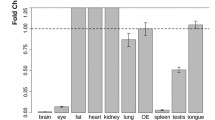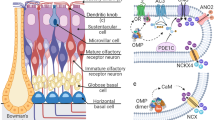Abstract
The olfactory marker protein (OMP) is expressed in mature chemosensory neurons in the nasal neuroepithelium. Here, we report the identification of a novel population of OMP-expressing neurons located bilaterally in the anterior/dorsal region of each nasal cavity at the septum. These cells are clearly separated from the regio olfactoria, harboring the olfactory sensory neurons. During mouse development, the arrangement of the anterior OMP-cells undergoes considerable change. They appear at about stage E13 and are localized in the nasal epithelium during early stages; by epithelial budding, ganglion-shaped clusters are formed in the mesenchyme during the perinatal phase, and a filiform layer directly underneath the nasal epithelium is established in adults. The anterior OMP-cells extend long axonal processes which form bundles and project towards the brain. The data suggest that the newly discovered group of OMP-cells in the anterior region of the nasal cavity may serve a distinct sensory function.










Similar content being viewed by others
Abbreviations
- OMP:
-
Olfactory marker protein
- MOE:
-
Main olfactory epithelium
- VNO:
-
Vomeronasal organ
- NC:
-
Nasal cavity
- OB:
-
Olfactory bulb
- GFP:
-
Green fluorescent protein
- DAPI:
-
4′,6-Diamidino-2-phenylindole
References
Asai DJ, Remolona NM (1989) Tubulin isotype usage in vivo: a unique spatial distribution of the minor neuronal-specific beta-tubulin isotype in pheochromocytoma cells. Dev Biol 132:398–409
Baker H, Grillo M, Margolis FL (1989) Biochemical and immunocytochemical characterization of olfactory marker protein in the rodent central nervous system. J Comp Neurol 285(2):246–261
Baker H, Farbman AI (1993) Olfactory afferent regulation of the dopamine phenotype in the fetal rat olfactory system. Neuroscience 52:115–134
Bigiani A, Mucignat-Caretta C, Montani G, Tirindelli R (2005) Pheromone reception in mammals. Rev Physiol Biochem Pharmacol
Buiakova OI, Krishna NS, Getchell TV, Margolis FL (1994) Human and rodent OMP genes: conservation of structural and regulatory motifs and cellular localization. Genomics 20:452–462
Buiakova OI, Baker H, Scott JW, Farbman A, Kream R, Grillo M, Franzen L, Richman M, Davis LM, Abbondanzo S, Stewart CL, Margolis FL (1996) Olfactory marker protein (OMP) gene deletion causes altered physiological activity of olfactory sensory neurons. Proc Natl Acad Sci USA 93(18):9858–9863
de Olmos J, Hardy H, Heimer L (1978) The afferent connections of the main and the accessory olfactory bulb formations in the rat: an experimental HRP-study. J Comp Neurol 181:213–244
Demski LS, Northcutt RG (1983) The terminal nerve: a new chemosensory system in vertebrates? Science 220:435–437
Finger TE, St Jeor VL, Kinnamon JC, Silver WL (1990) Ultrastructure of substance P- and CGRP-immunoreactive nerve fibers in the nasal epithelium of rodents. J Comp Neurol 294:293–305
Grüneberg H (1973) A ganglion probably belonging to the N terminalis system in the nasal mucosa of the mouse. Z Anat Entwicklungsgesch 140:39–52
Heimer L (1968) Synaptic distribution of centripetal and centrifugal nerve fibres in the olfactory system of the rat. An experimental anatomical study. J Anat 103:413–432
Honig MG, Hume RI (1989) Dil and diO: versatile fluorescent dyes for neuronal labelling and pathway tracing. Trends Neurosci 12:333–335
Johnson EW, Eller PM, Jafek BW (1993) An immuno-electron microscopic comparison of olfactory marker protein localization in the supranuclear regions of the rat olfactory epithelium and vomeronasal organ neuroepithelium. Acta Otolaryngol 113:766–771
Katsetos CD, Legido A, Perentes E, Mork SJ (2003) Class III beta-tubulin isotype: a key cytoskeletal protein at the crossroads of developmental neurobiology and tumor neuropathology. J Child Neurol 18:851–867
Kyle AL, Sorenson PW, Stacey NE, Dulka JG (1987) Medial olfactory tract pathways controlling sexual reflexes and behavior in teleosts. In: Demski LS, Schwanzel-Fukuda M (eds) The terminal nerve (nervus terminalis). Structure, function and evolution. Ann NY Acad Sci, vol 519, pp 97–107
Levai O, Strotmann J ( 2003) Projection pattern of nerve fibers from the septal organ: DiI-tracing studies with transgenic OMP mice. Histochem Cell Biol 120:483–492
Margolis FL (1980) A marker protein for the olfactory chemoreceptor neuron. In: Bradshaw RA, Schneider DM (eds) Proteins of the nervous system. Raven, New York, pp 59–84
Potter SM, Zheng C, Koos DS, Feinstein P, Fraser SE, Mombaerts P (2001) Structure and emergence of specific olfactory glomeruli in the mouse. J Neurosci 21:9713–9723
Rogers KE, Dasgupta P, Gubler U, Grillo M, Khew-Goodall YS, Margolis FL (1987) Molecular cloning and sequencing of a cDNA for olfactory marker protein. Proc Natl Acad Sci USA 84:1704–1708
Schwanzel-Fukuda M, Silverman AJ (1980) The nervus terminalis of the guinea pig: a new luteinizing hormone-releasing hormone (LHRH) neuronal system. J Comp Neurol 191:213–225
Schwanzel-Fukuda M, Pfaff DW (1989) Origin of luteinizing hormone-releasing hormone neurons. Nature 338:161–164
Schwanzel-Fukuda M, Pfaff DW (1989) Origin of luteinizing hormone-releasing hormone neurons. Nature 338:161–164
Schwanzel-Fukuda M, Pfaff DW (2003) The structure and function of the nervus terminalis. In: Doty RL (ed) Handbook of olfaction and gustation. Marcel Dekker Inc, New York, pp 1001–1026
Schwarzenbacher K, Fleischer J, Breer H, Conzelmann S (2004) Expression of olfactory receptors in the cribriform mesenchyme during prenatal development. Gene Expr Patterns 4:543–552
Tarozzo G, Peretto P, Perroteau I, Andreone C, Varga Z, Nicholls J, Fasolo A (1994a) GnRH neurons and other cell populations migrating from the olfactory neuroepithelium. Ann Endocrinol (Paris) 55:249–254
Tarozzo G, Peretto P, Varga Z, Andreone C, Fasolo A (1994b) Cell migration during development of the olfactory system in the newborn opossum, Monodelphis domestica, in vivo and in vitro. Soc Neurosci Abstr 20:682
Tarozzo G, Peretto P, Fasolo A (1995) Cell migration from the olfactory placode and the ontogeny of the neuroendocrine compartment. Zool Sci 12:367–383
Tarozzo G, De Andrea M, Feuilloey M, Vaudry H, Fasolo A (1998) Molecular and cellular guidance of neuronal migration in the developing olfactory system of rodents. Ann N Y Acad Sci 839:196–200
Valverde F, Heredia M, Santacana M (1993) Characterization of neuronal cell varieties migrating from the olfactory epithelium during prenatal development in the rat. Immunocytochemical study using antibodies against olfactory marker protein (OMP) and luteinizing hormone-releasing hormone (LH-RH). Brain Res Dev Brain Res 71:209–220
Waguespack AM, Reems MR, Butman ML, Cherry JA, Coppola DM (2005) Naris occlusion alters olfactory marker protein immunoreactivity in olfactory epithelium. Brain Res 1044(1):1–7
Wirsig CR, Leonard CM (1987) Terminal nerve damage impairs the mating behavior of the male hamster. Brain Res 417:293–303
Witkin JW (1987) Luteinizing hormone-releasing hormone (LHRH) in olfactory systems in primates. In: Demski LS, Schwanzel-Fukuda M (eds) The terminal nerve. Structur, function and evolution. Ann NY Acad Sci, vol. 519, pp 174–183
Wray S, Grant P, Gainer H (1989) Evidence that cells expressing luteinizing hormone-releasing hormone mRNA in the mouse are derived from progenitor cells in the olfactory placode. Proc Natl Acad Sci USA 86(20):8132–8136
Youngentob SL, Margolis FL (1999) OMP gene deletion causes an elevation in behavioral threshold sensitivity. Neuroreport 10(1):15–19
Youngentob SL, Margolis FL, Youngentob LM (2001) OMP gene deletion results in an alteration in odorant quality perception. Behav Neurosci 115(3):626–631
Youngentob SL, Pyrski MM, Margolis FL (2004) Adenoviral vector-mediated rescue of the OMP-null behavioral phenotype: enhancement of odorant threshold sensitivity. Behav Neurosci 118(3):636–642
Acknowledgements
This work was supported by the Deutsche Forschungsgemeinschaft (SFB 495).
Author information
Authors and Affiliations
Corresponding author
Rights and permissions
About this article
Cite this article
Fleischer, J., Hass, N., Schwarzenbacher, K. et al. A novel population of neuronal cells expressing the olfactory marker protein (OMP) in the anterior/dorsal region of the nasal cavity. Histochem Cell Biol 125, 337–349 (2006). https://doi.org/10.1007/s00418-005-0077-x
Accepted:
Published:
Issue Date:
DOI: https://doi.org/10.1007/s00418-005-0077-x




